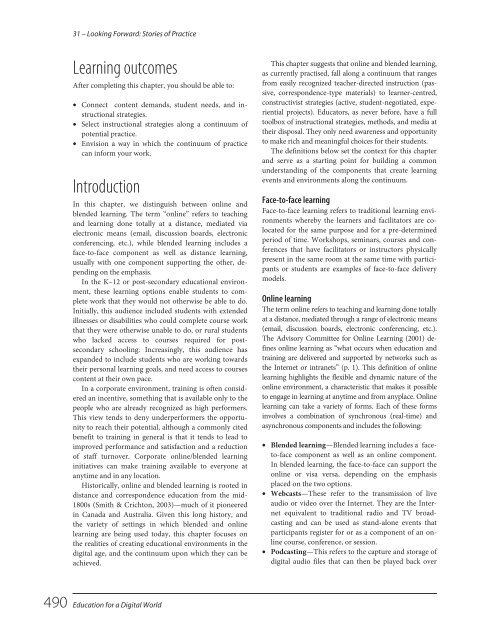Education for a Digital World Advice, Guidelines and Effective Practice from Around Globe, 2008a
Education for a Digital World Advice, Guidelines and Effective Practice from Around Globe, 2008a
Education for a Digital World Advice, Guidelines and Effective Practice from Around Globe, 2008a
Create successful ePaper yourself
Turn your PDF publications into a flip-book with our unique Google optimized e-Paper software.
31 – Looking Forward: Stories of <strong>Practice</strong><br />
Learning outcomes<br />
After completing this chapter, you should be able to:<br />
• Connect content dem<strong>and</strong>s, student needs, <strong>and</strong> instructional<br />
strategies.<br />
• Select instructional strategies along a continuum of<br />
potential practice.<br />
• Envision a way in which the continuum of practice<br />
can in<strong>for</strong>m your work.<br />
Introduction<br />
In this chapter, we distinguish between online <strong>and</strong><br />
blended learning. The term “online” refers to teaching<br />
<strong>and</strong> learning done totally at a distance, mediated via<br />
electronic means (email, discussion boards, electronic<br />
conferencing, etc.), while blended learning includes a<br />
face-to-face component as well as distance learning,<br />
usually with one component supporting the other, depending<br />
on the emphasis.<br />
In the K–12 or post-secondary educational environment,<br />
these learning options enable students to complete<br />
work that they would not otherwise be able to do.<br />
Initially, this audience included students with extended<br />
illnesses or disabilities who could complete course work<br />
that they were otherwise unable to do, or rural students<br />
who lacked access to courses required <strong>for</strong> postsecondary<br />
schooling. Increasingly, this audience has<br />
exp<strong>and</strong>ed to include students who are working towards<br />
their personal learning goals, <strong>and</strong> need access to courses<br />
content at their own pace.<br />
In a corporate environment, training is often considered<br />
an incentive, something that is available only to the<br />
people who are already recognized as high per<strong>for</strong>mers.<br />
This view tends to deny underper<strong>for</strong>mers the opportunity<br />
to reach their potential, although a commonly cited<br />
benefit to training in general is that it tends to lead to<br />
improved per<strong>for</strong>mance <strong>and</strong> satisfaction <strong>and</strong> a reduction<br />
of staff turnover. Corporate online/blended learning<br />
initiatives can make training available to everyone at<br />
anytime <strong>and</strong> in any location.<br />
Historically, online <strong>and</strong> blended learning is rooted in<br />
distance <strong>and</strong> correspondence education <strong>from</strong> the mid-<br />
1800s (Smith & Crichton, 2003)—much of it pioneered<br />
in Canada <strong>and</strong> Australia. Given this long history, <strong>and</strong><br />
the variety of settings in which blended <strong>and</strong> online<br />
learning are being used today, this chapter focuses on<br />
the realities of creating educational environments in the<br />
digital age, <strong>and</strong> the continuum upon which they can be<br />
achieved.<br />
This chapter suggests that online <strong>and</strong> blended learning,<br />
as currently practised, fall along a continuum that ranges<br />
<strong>from</strong> easily recognized teacher-directed instruction (passive,<br />
correspondence-type materials) to learner-centred,<br />
constructivist strategies (active, student-negotiated, experiential<br />
projects). Educators, as never be<strong>for</strong>e, have a full<br />
toolbox of instructional strategies, methods, <strong>and</strong> media at<br />
their disposal. They only need awareness <strong>and</strong> opportunity<br />
to make rich <strong>and</strong> meaningful choices <strong>for</strong> their students.<br />
The definitions below set the context <strong>for</strong> this chapter<br />
<strong>and</strong> serve as a starting point <strong>for</strong> building a common<br />
underst<strong>and</strong>ing of the components that create learning<br />
events <strong>and</strong> environments along the continuum.<br />
Face-to-face learning<br />
Face-to-face learning refers to traditional learning environments<br />
whereby the learners <strong>and</strong> facilitators are colocated<br />
<strong>for</strong> the same purpose <strong>and</strong> <strong>for</strong> a pre-determined<br />
period of time. Workshops, seminars, courses <strong>and</strong> conferences<br />
that have facilitators or instructors physically<br />
present in the same room at the same time with participants<br />
or students are examples of face-to-face delivery<br />
models.<br />
Online learning<br />
The term online refers to teaching <strong>and</strong> learning done totally<br />
at a distance, mediated through a range of electronic means<br />
(email, discussion boards, electronic conferencing, etc.).<br />
The Advisory Committee <strong>for</strong> Online Learning (2001) defines<br />
online learning as “what occurs when education <strong>and</strong><br />
training are delivered <strong>and</strong> supported by networks such as<br />
the Internet or intranets” (p. 1). This definition of online<br />
learning highlights the flexible <strong>and</strong> dynamic nature of the<br />
online environment, a characteristic that makes it possible<br />
to engage in learning at anytime <strong>and</strong> <strong>from</strong> anyplace. Online<br />
learning can take a variety of <strong>for</strong>ms. Each of these <strong>for</strong>ms<br />
involves a combination of synchronous (real-time) <strong>and</strong><br />
asynchronous components <strong>and</strong> includes the following:<br />
• Blended learning—Blended learning includes a faceto-face<br />
component as well as an online component.<br />
In blended learning, the face-to-face can support the<br />
online or visa versa, depending on the emphasis<br />
placed on the two options.<br />
• Webcasts—These refer to the transmission of live<br />
audio or video over the Internet. They are the Internet<br />
equivalent to traditional radio <strong>and</strong> TV broadcasting<br />
<strong>and</strong> can be used as st<strong>and</strong>-alone events that<br />
participants register <strong>for</strong> or as a component of an online<br />
course, conference, or session.<br />
• Podcasting—This refers to the capture <strong>and</strong> storage of<br />
digital audio files that can then be played back over<br />
490 <strong>Education</strong> <strong>for</strong> a <strong>Digital</strong> <strong>World</strong>


















